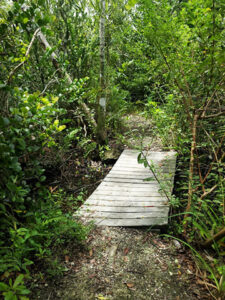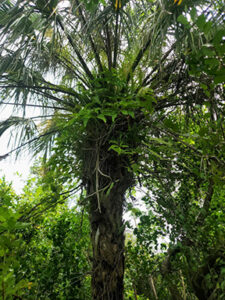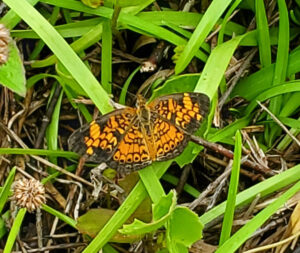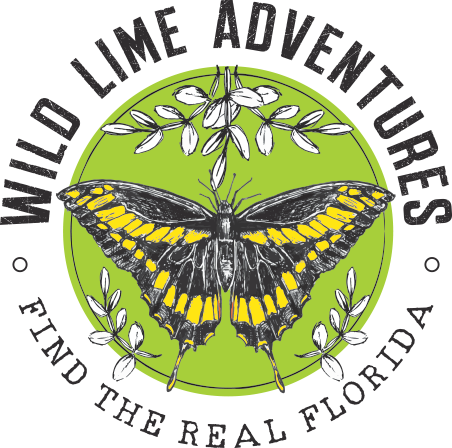One of the special habitats of the Everglades is the tropical hardwood hammock. And one of the easiest ones to get to and explore is right in Shark Valley, the northern entrance of Everglades National Park. This is a familiar location for many locals. One can take a bike ride on the 15-mile loop, or simply walk the main trail. Either way, stop for a moment at the trailhead that is about 1 mile from the visitor center on the western side, called River Otter Cove Trail.
 This tropical hardwood hammock is quite beautiful and large as hammocks go. Watch your step! Despite being only a quarter mile in length, the trail takes you across exposed limestone, fallen trees, footbridges, around solution holes, and depending on the time of year, over some muddy spots, or even through water. It is a short trail, enabling visitors to experience a true tropical hardwood hammock, with its special assortment of flora and fauna.
This tropical hardwood hammock is quite beautiful and large as hammocks go. Watch your step! Despite being only a quarter mile in length, the trail takes you across exposed limestone, fallen trees, footbridges, around solution holes, and depending on the time of year, over some muddy spots, or even through water. It is a short trail, enabling visitors to experience a true tropical hardwood hammock, with its special assortment of flora and fauna.
The hammock like most others in the Everglades is teardrop shaped due to the north to south flow of water of the “River of Grass.” The larger part is at the top and includes some larger trees. It floods less there. The bottom part is referred to as a bayhead and is more prone to flooding
in the rainy season.  Hammocks are surrounded by water and are slightly elevated from the surrounding area, protecting them from fire, thus allowing for larger trees. Some of the trees in this hammock are the cabbage palm (sabal palm), poisonwood, sweet bay, gumbo limbo, strangler fig, coastal plain willow, coco plum, wax myrtle, pond apple, and bald cypress. When entering the north side of the trail, glance to your right to spot the beautifully delicate epiphytes amidst the trees.
Hammocks are surrounded by water and are slightly elevated from the surrounding area, protecting them from fire, thus allowing for larger trees. Some of the trees in this hammock are the cabbage palm (sabal palm), poisonwood, sweet bay, gumbo limbo, strangler fig, coastal plain willow, coco plum, wax myrtle, pond apple, and bald cypress. When entering the north side of the trail, glance to your right to spot the beautifully delicate epiphytes amidst the trees.
 Epiphytes are plants that use other plants and trees as support in tropical climes. As you move along the trail try to identify plants like grey nickerbean, muscadine, pepper vine, native porterweed, water pennywort, partridge pea, and more. Pay attention. You just may see a snake. There are Everglades racers, black racers, brown water snakes, rough green snakes, rat snakes, the Everglades corn snake, and the venomous water moccasin (cottonmouth). You could also see beautiful butterfly species such as the white peacock, pearl crescent, the state butterfly of Florida – the zebra longwing, and perhaps even the spectacular Palamedes swallowtail. It is a fascinating little walk because you may also see an alligator up close, and who knows, maybe even have a chance spotting of a river otter!
Epiphytes are plants that use other plants and trees as support in tropical climes. As you move along the trail try to identify plants like grey nickerbean, muscadine, pepper vine, native porterweed, water pennywort, partridge pea, and more. Pay attention. You just may see a snake. There are Everglades racers, black racers, brown water snakes, rough green snakes, rat snakes, the Everglades corn snake, and the venomous water moccasin (cottonmouth). You could also see beautiful butterfly species such as the white peacock, pearl crescent, the state butterfly of Florida – the zebra longwing, and perhaps even the spectacular Palamedes swallowtail. It is a fascinating little walk because you may also see an alligator up close, and who knows, maybe even have a chance spotting of a river otter!
This story would be sorely remiss without mentioning that it was once home to families of Miccosukee people who lived there until the national park was formed in 1947. The place where they had their chickees (their thatch covered houses) is overgrown now, but at certain times of the year one can still catch the faint aroma of ripe grapefruit lingering in the air, a subtle reminder of their lives once spent hidden among the trees. Take a moment to pause and reflect on the amazing people who once called this hammock home. It is a place quite accessible and special, so stop for a quiet visit, even as many others obliviously pass it by.

